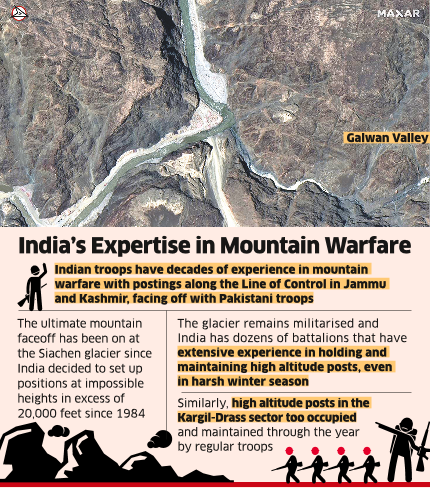At Galwan, Chinese Roads Washed Away By Spate In The River

Despite talks, China retains a strong presence in the Galwan valley, with at least 16 camps, including one that is on the Indian side of the Line of Actual Control (LAC). The Chinese deployment at ‘Y Nalla’ has cut off access for Indian troops to Patrol Point 14, where patrolling was carried out in the past before the PLA changed the status quo.
Sources said that specialised mountain troops have now been deployed to take control of strategic heights along the narrow valley and the Indian side has built up adequate forces in the area to prepare for any eventuality.
 New Delhi: India has taken up strategic positions along the heights in Galwan Valley as the Chinese side remains dug in, with satellite images showing that several posts set up by the PLA along the river have been affected by a sudden spate of water in the past few days.
New Delhi: India has taken up strategic positions along the heights in Galwan Valley as the Chinese side remains dug in, with satellite images showing that several posts set up by the PLA along the river have been affected by a sudden spate of water in the past few days.
Despite talks, China retains a strong presence in the Galwan valley, with at least 16 camps visible within a 10 km span, including one that is on the Indian side of the Line of Actual Control (LAC). As reported by ET, the Chinese deployment at ‘Y Nalla’ has cut off access for Indian troops to Patrol Point 14, where patrolling was carried out in the past before the PLA changed the status quo.
Sources said that specialised mountain troops have now been deployed to take control of strategic heights along the narrow valley and the Indian side has built up adequate forces in the area to prepare for any eventuality.
In mountain warfare, the key to success is occupying heights while troops at lower altitudes face a major handicap. China has over the past two months expanded the narrow valley artificially by digging up the Galwan river and creating additional banks on the sides to move in troops.
Satellite images show that several of these encampments have recently got isolated, possibly due to a sudden spate of water in the river that has washed away crossing point. China has specialised in altering landscapes for military purposes, like the creation of artificial islands in the South China Sea. However, the mountainous terrain is very punishing and prone to bringing about quick changes.
Indian troops have decades of experience in mountain warfare with postings along the Line of Control in Jammu and Kashmir, facing off with Pakistani troops. The ultimate mountain faceoff has been on at the Siachen glacier since India decided to set up positions at impossible heights in excess of 20,000 feet since 1984.
The glacier remains militarised and India has dozens of battalions that have extensive experience in holding and maintaining high altitude posts, even through the harsh winter season. Similarly, high altitude posts in the Kargil-Drass sector too are occupied and maintained through the year by regular troops.



No comments:
Post a Comment